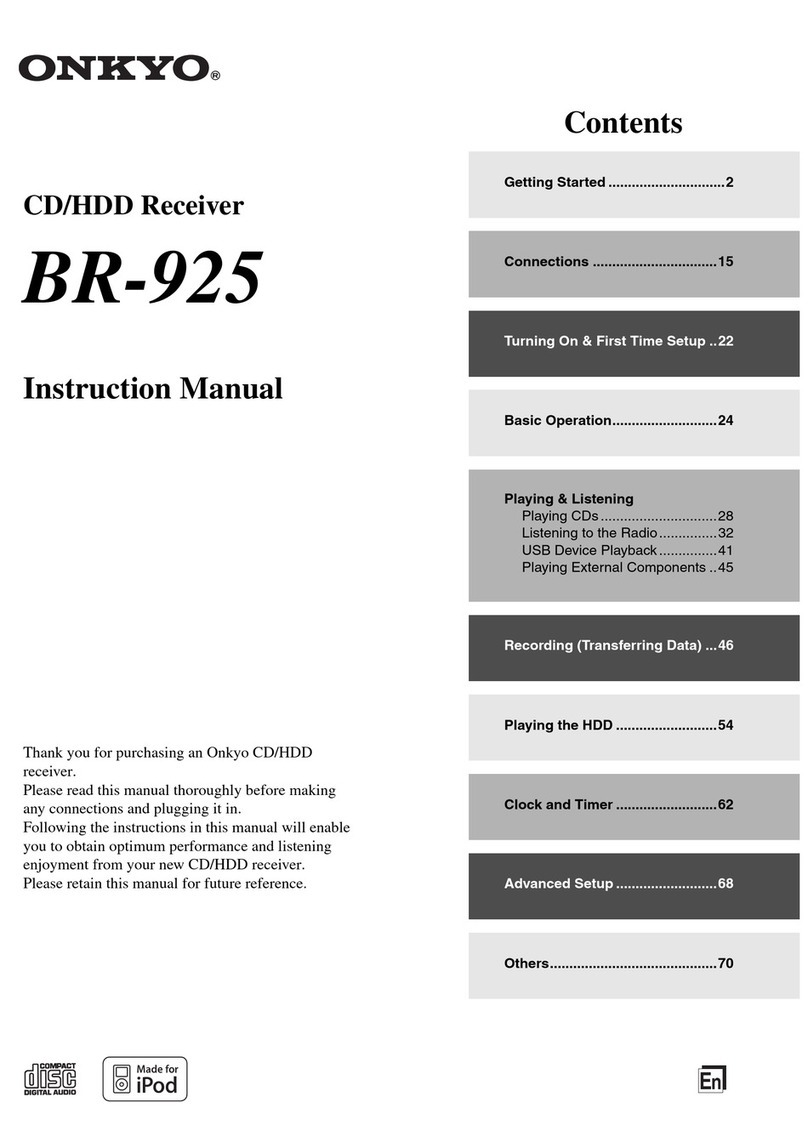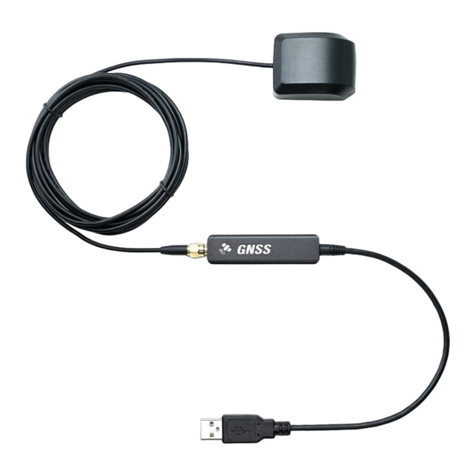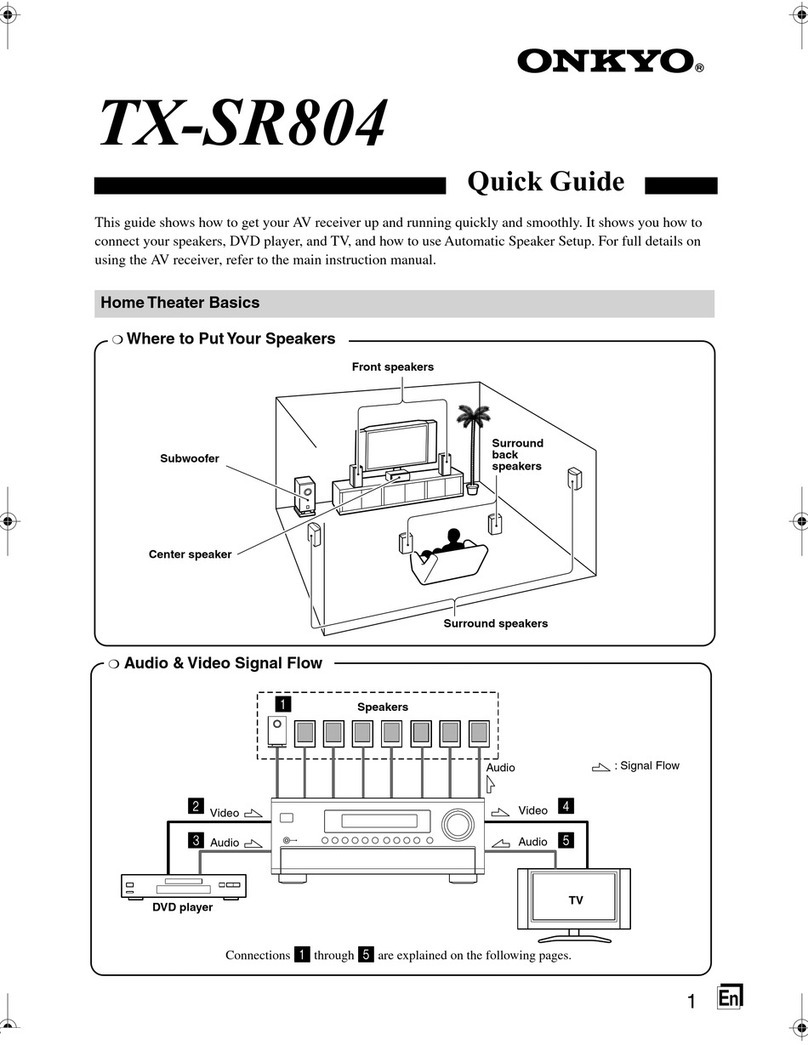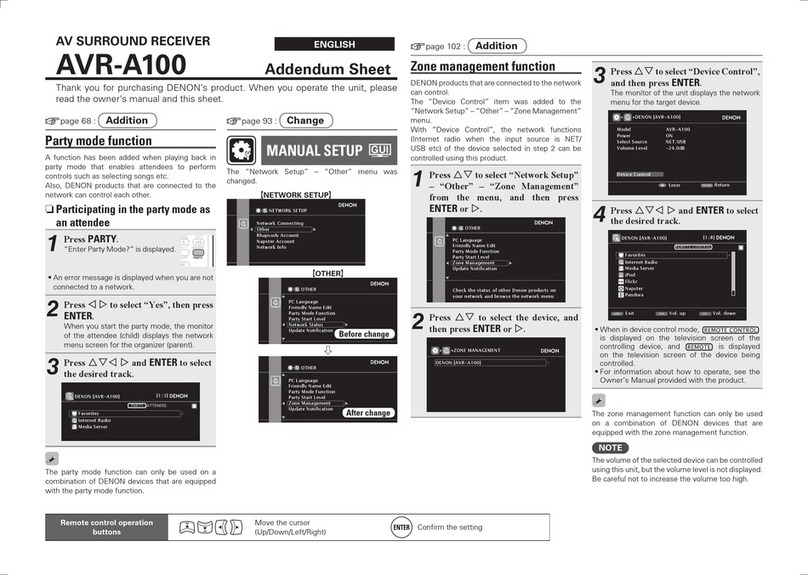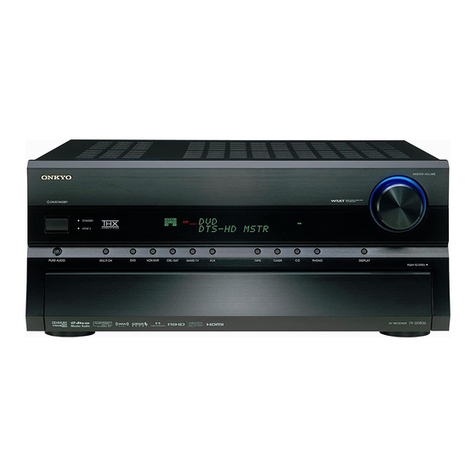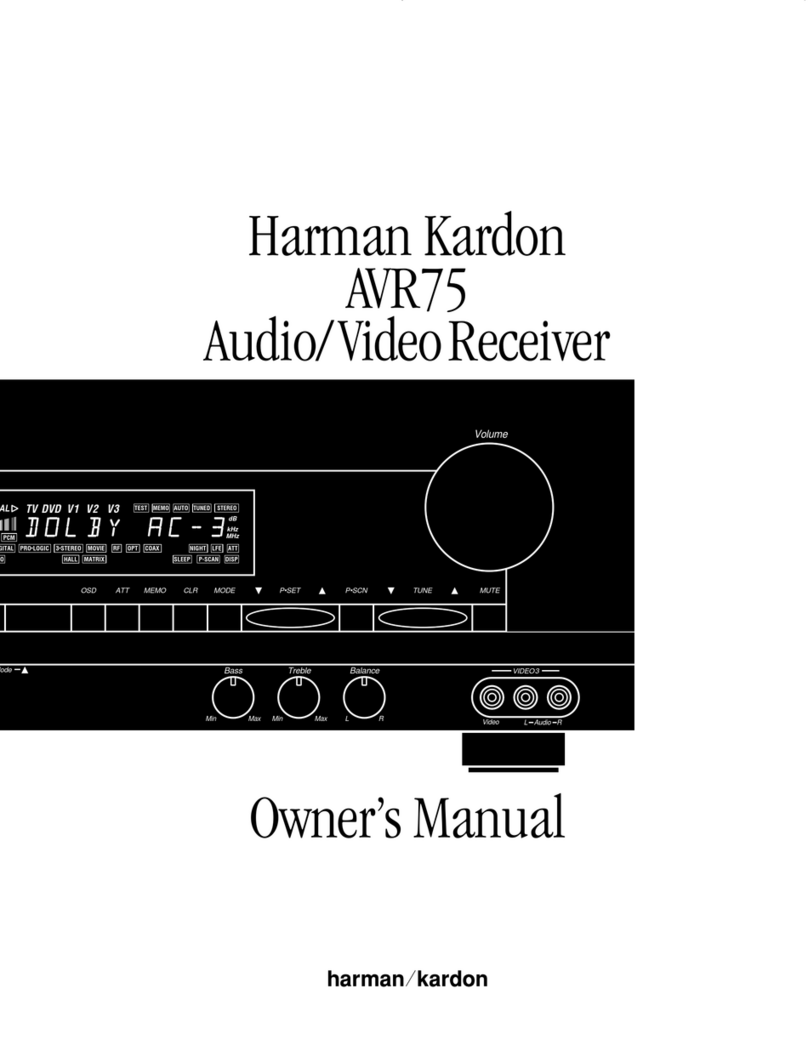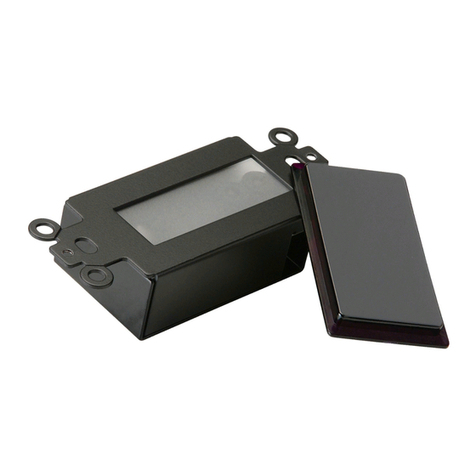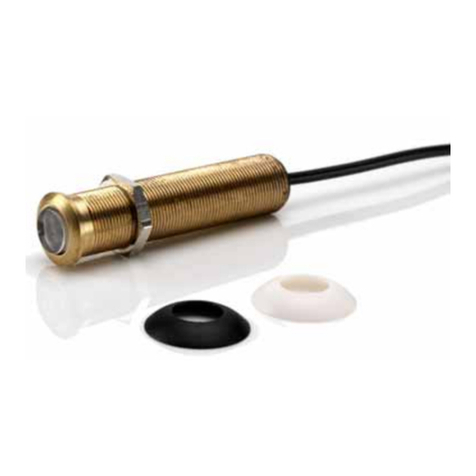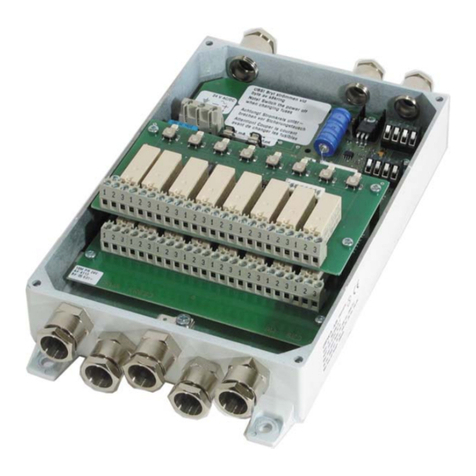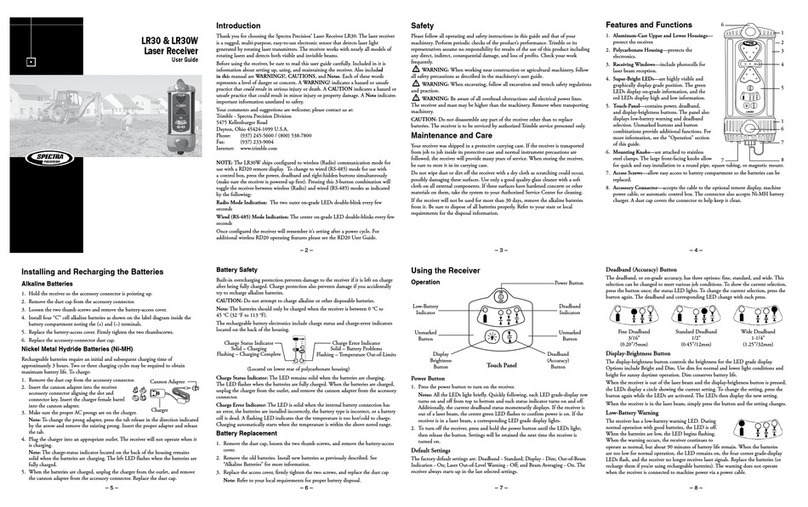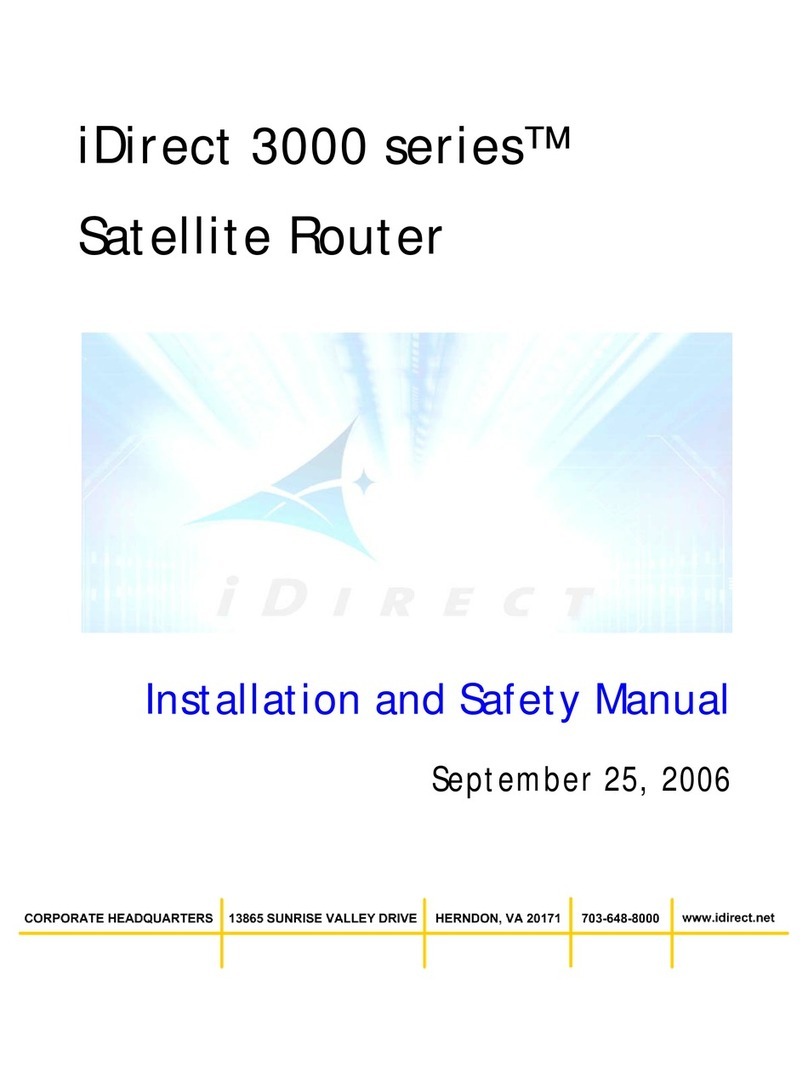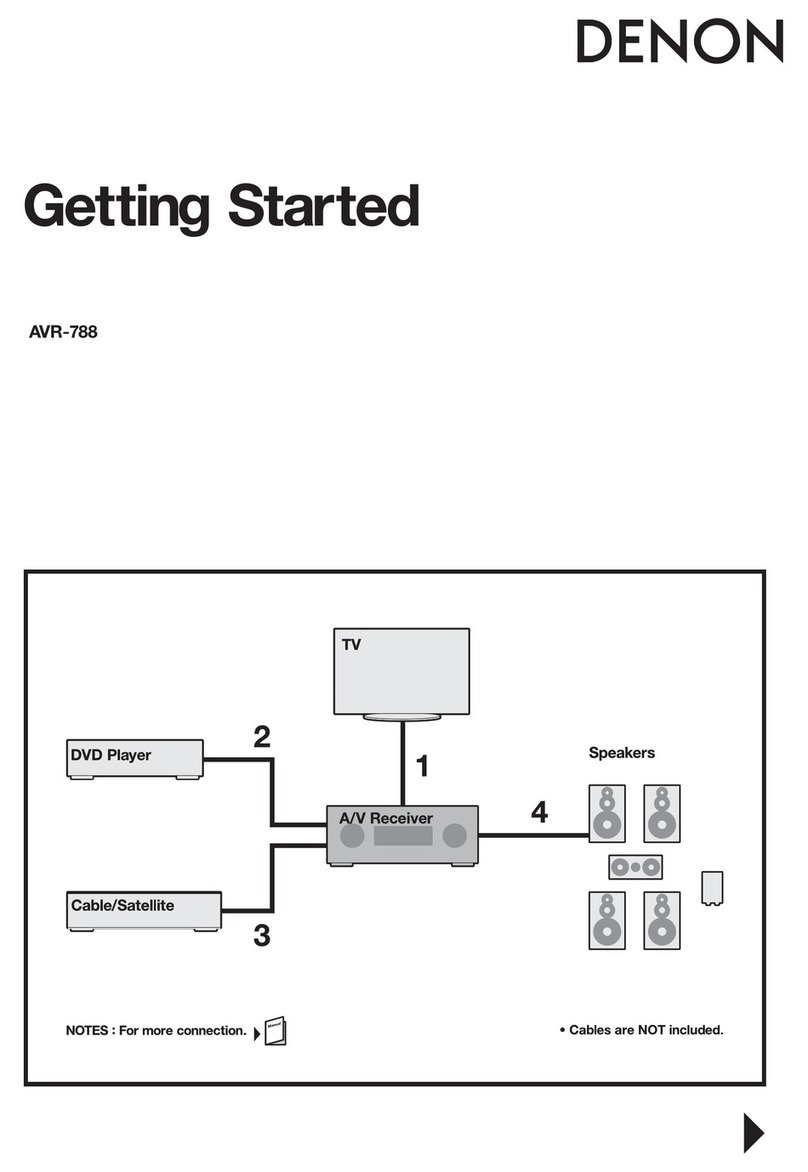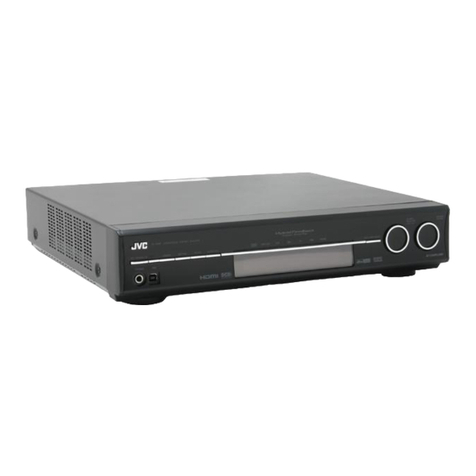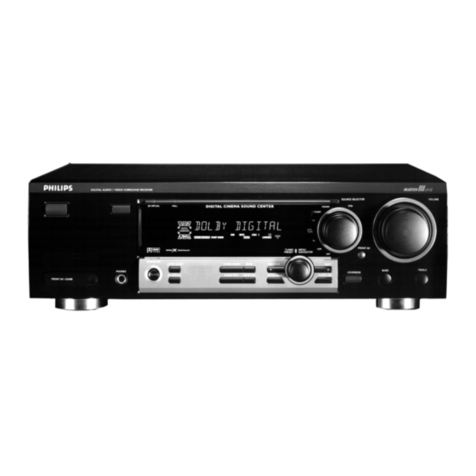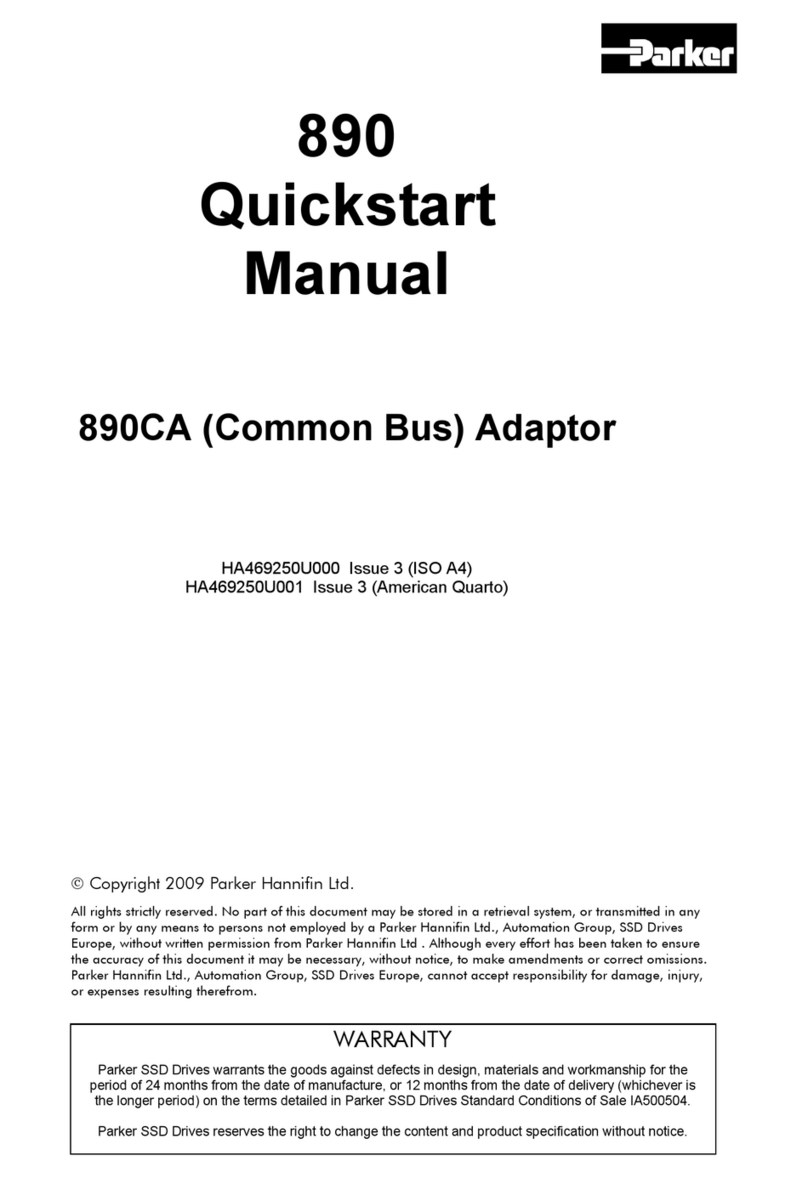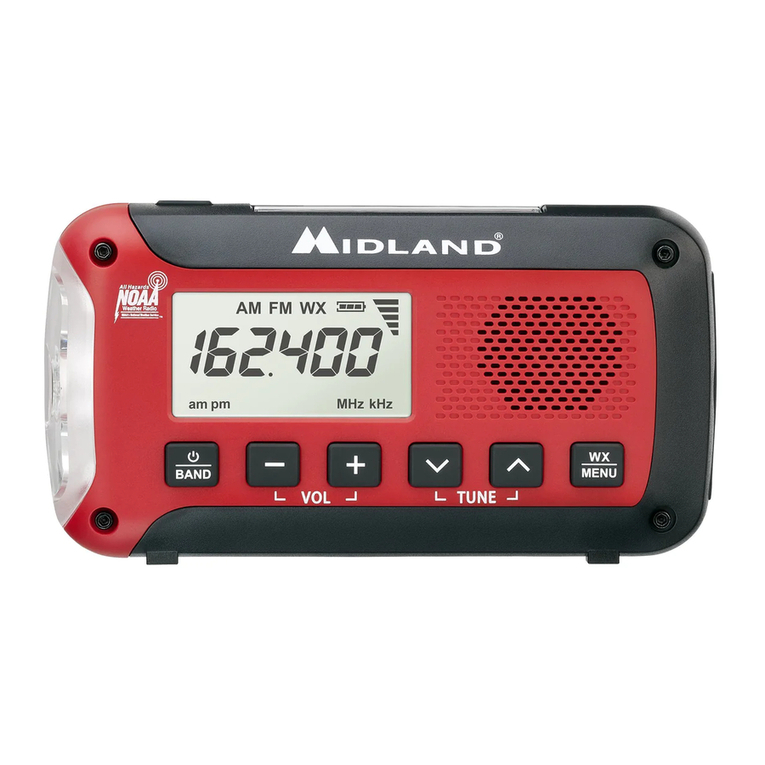Datawell 45100 User manual

Datawell Waverider
Receiver
Manual
RX-D type 2
from serial no.: 45100
October 14, 2015
Service & Sales
Voltastraat 3
1704 RP Heerhugowaard
The Netherlands
+31 72 534 5298
+31 72 572 6406
www.datawell.nl

2
Check if mains supply matches with the specifications of the device.

3
Contents
1 Introduction ................................................................................................... 5
2 Front- and back-panel layout ....................................................................... 7
3 Installation ..................................................................................................... 9
3.1 Power supply............................................................................................ 9
3.2 Receiving antenna ................................................................................... 9
3.3 Connecting the serial output to a PC...................................................... 10
3.4 Grounding .............................................................................................. 10
3.5 Lightning protection................................................................................ 11
4 Operation ..................................................................................................... 13
4.1 Receiving data ....................................................................................... 13
4.1.1 GPS position ................................................................................... 14
4.1.2 Signal quality................................................................................... 14
4.1.3 Speaker........................................................................................... 14
4.2 Checking the receiver alignment ............................................................ 14
4.2.1 Realignment procedure................................................................... 15
4.3 Changing the reception frequency ......................................................... 16
4.3.1 Crystal exchange procedure ........................................................... 16
4.4 W@ves21 and SeaSaw21 ..................................................................... 16
5 Troubleshooting .......................................................................................... 17
5.1 Power and fuses .................................................................................... 17
5.2 Antenna, signal quality and noise........................................................... 17
5.3 Data interface......................................................................................... 18
6 Specifications .............................................................................................. 19
7 Contact information .................................................................................... 21
Appendix A: Buoy HF data link and range ................................................... 22
Appendix B: Output message format ........................................................... 31
Appendix C: WAREC compatibility considerations .................................... 32
Appendix D: Abbreviations ........................................................................... 33
Appendix E: Receiving antennas.................................................................. 34

4

5
1 Introduction
The RX-D type 2 (RX-D2) is a HF link receiver that can receive all current Datawell Waverider
buoys with a standard (FSK) HF link transmitter.
The RX-D2 is tuned to the reception frequency using exchangeable receiving crystals. The RX-
D2 is connected to a PC running W@ves21 using RS232.
In Chapters 2,3 and 4 of this manual the installation and operation of the RX-D2 are discussed.
Chapter 5 gives some solutions to common problems while Chapter 6 discusses the
specifications of the RX-D2.

6

7
2 Front- and back-panel layout
The front panel contains the LCD and the speaker / test button.
The back panel contains the following connectors:
Socket for mains supply with fuses.
Audio out for beat-note monitoring.
Female 9-pin RS232 connector.
Antenna input connector.

8

9
3 Installation
This chapter describes how to install the RX-D2. To function correctly, an RX-D2 needs at least
the following:
Power supply.
Receiving antenna.
Connection to a PC using the serial port.
The following paragraphs will discuss these connections as well as grounding and lightning
protection considerations.
3.1 Power supply
The RX-D2 is fed from an AC power source with a voltage between 100 and 240 V. Please
refer to paragraph 6 for the exact voltage and power requirements.
The customer should provide for a cord set terminated with connector type C13 according to
IEC 60320-1 and a mains plug in accordance with national standards. The RX-C is a class I
appliance and requires an earthed socket for connection to protective-earth.
3.2 Receiving antenna
General HF link considerations
Directional Waverider buoys use a low power HF transmitter. The transmitting antenna is a
vertically polarized quarter wavelength whip. The receiving end of the link should receive as
much signal from the buoy transmitter and as little noise and interference as possible. To
achieve this the receiving antenna and -station should preferably be located at or near the coast,
see Appendix A and Appendix E for more information.
Receiving antenna location and height
The transmitter antenna is vertically polarised, therefore the receiving antenna must also be
mounted vertically. For the assembly of the antenna and adjustment of its length to the transmit
frequency see Appendix E.
Over sea the fieldstrength does not vary significantly with the height of the receiving antenna up
to 100 m. If the receiving antenna can be located within a few tens of meters of the sea, its
height is not important.
Over land the fieldstrength is attenuated by RF losses in the ground. For this reason it is
recommended that the antenna should be placed within a few tens of meters of the sea if
possible. If the distance from the sea is greater, the ground losses can (partially) be compensated
for by mounting the antenna at an height up to 20-30 meters. Generally, more than 20 -30m
above sea level will not improve the reception quality.
If possible mount the antenna in such a way that it has a free “sight”in the direction of the buoy.
Large structures such as embankments, ships and buildings in the direct optical path to the buoy
will attenuate the received signal.
For interference free reception it is advisable to install the Receiving antenna as far as possible
from local interference sources such as combustion engines, electric motors and fluorescent
lamps. In general a transmitting distance of 50 Km (30 n.m.) over sea water can be attained
when the receiving antenna is located at least 100 m from interference sources mentioned. If

10
considerable interference is present at the location where the receiving equipment has to be
installed, the antenna should be moved to a position with lower interference. Also the use of a
directional antenna (see Appendix E) can be considered. Transmission range of the DWR-G
0.4m is less: line of sight with a handheld receiving antenna and 25 Km with a ground plane
antenna.
Installing the antenna cable
The length of the antenna cable is not critical as long as a good quality coaxial cable is used.
The supplied RG 213 cable has an attenuation of 3.5 dB/100m allowing up to 200m of cable
lengths. However, shorter cable lengths are always preferred to improve the signal to noise
ratio. Especially in signal limited situations (where signals of buoys at the edge of the normal
range must be received) the cable should be no longer than strictly necessary. Install the coaxial
cable without stretching or bending and avoid mechanical stress. With respect to routing there
are few restrictions. Although the cable is screened and not very sensitive to surrounding
electric or magnetic fields and disturbances, try to avoid routing the cable directly along power
cabling.
Be aware of the fact that reception in most areas is limited by local noise and interference. It
pays to install the antenna in such a way that distance to local sources of noise and interference
is maximized. In these situations, it is entirely acceptable to use a longer cable in order to install
the antenna further away from a source of interference.
Using a directional antenna
In case of weak signal and/or high local noise or interference the use of a directional antenna
can be considered. The sensitivity of such an antenna is 3 dB higher in the direction of the buoy.
Interference and noise generated at the landside will be attenuated by 6 dB. The combination of
gain at the frontside (thus towards the buoy) and suppression of noise from the backside of the
antenna will improve the signal to noise ratio.
Using an antenna splitter
For connecting multiple receivers to a single antenna, the Datawell Antenna Splitter can be
used. This device is optimized for the buoy reception frequencies and signal levels. With the
Datawell Antenna Splitter up to six receivers can be used with a single antenna.
3.3 Connecting the serial output to a PC
Connection of the serial output to a PC is done using a standard D-SUB RS232 cable assembly.
The receiver has a nine pin D-SUB outlet of which only pins 2 and 3 carry active signals. Pin 5
is signal ground. Normal RS232 cable length restrictions apply. RS232 ports are becoming
scarce on PC’s, in favour of USB ports. This problem may be solved with a RS232-USB serial
adapter. However, some adapter models do not offer the same data transmission reliability as
RS232 serial connections do.
3.4 Grounding
For correct reception of buoy signals grounding of the antenna is not necessary. The supplied
ground plane antenna takes care of its own RF reference. Also grounding of the receiver and/or
connected computer is not a remedy for all kind of noises and disturbances. Noise and trouble
free reception should be possible without any connection or reference to ground.
However from a viewpoint of safety it is recommended to connect the receiver to a safety
ground. Normally the three wire power cord will take care of this.

11
3.5 Lightning protection
For effective protection against lightning strike it is advisable to connect the antenna supporting
structure to a ground electrode that is suitable for lightning protection. In the case that the
building or adjoining buildings and/or mast on which the antenna is installed is already lightning
protected it is sufficient to connect the antenna supporting structure to this grounding net. Also
the antenna cable should be protected with an impulse suppressor at the point where the antenna
cable enters the building. This impulse suppressor should be grounded properly. When in doubt
leave lightning protection to skilled consultants and/or companies.

12

13
4 Operation
This chapter describes the general operation of the RX-D2. For a description of the normal
operation of the RX-D2, refer to paragraph 4.1.
When the reception frequency needs to be changed, refer to paragraph 4.3.
4.1 Receiving data
When the receiver is in normal operating mode, the current status of the receiver is shown on
the display (see figure 4.1). To correctly receive and decode the buoy signal, the receiver must
first “synchronize” with the buoy signal. The status of this process is shown by the messages on
the display. There are four messages defined:
“synchronizing”
This message indicates that the receiver is synchronizing. This message appears after the
receiver has been switched on, after the receiving frequency has been changed or when the
receiver has lost the buoy signal.
“checking sync”
This message indicates that the receiver has just (re)synchronized. The receiver is now
validating the buoy signal.
“heave: 0153 cm”
This message (see figure 4.1) indicates that the receiver is correctly synchronized and
receiving data. The heave value is the actual, real-time vertical displacement of the buoy.
“bad vector”
This message indicates a transmission error.
Figure 4.1. Receiving data.
Normally, after power up or loss of signal, the receiver will display “synchronizing” for some
time and then display “checking sync”. After the receiver has validated the synchronization
process, the “heave” messages will be displayed. If too many transmission errors are detected,
the receiver will try to resynchronize to the buoy signal.
NOTE: The process of synchronization can take anything between 30 seconds to several
minutes. The time needed to reach synchronization depends on several factors like
signal-strength, interference, noise bursts and type of buoy. During the synchronization process
it is possible that the display switches frequently between “synchronizing” and “checking
sync”. This is normal behaviour.

14
4.1.1 GPS position
When the buoy being received is equipped with a GPS module, the GPS position of the buoy is
shown on the display. The GPS position message is “rotated” with the heave message according
to the scheme shown in figure 4.2.
Figure 4.2. Heave message and GPS message rotating scheme.
Note that the update rate of the GPS position is defined by the received buoy. Please refer to the
buoy documentation for more information.
4.1.2 Signal quality
When displaying heave, a signal quality bar graph is shown on the display, see figure 4.2. The
signal quality indication is derived from the “frame error rate”(FER) parameter. A full-scale
deflection of this bar indicates that no errors are detected in the incoming vectors (FER = 0%)
while no deflection at all indicates that all vectors contain errors (FER = 100%).
4.1.3 Speaker
The speaker is used to get an audible indication of the signal quality. A 1500 Hz frequency-
modulated beat-note should be heard against a clean background (none or clean noise without
any sign of interference or noise bursts).
The speaker can be switched on and off by pressing the button.
4.2 Checking the receiver alignment
The RX-D2 has a built-in test mode that is used to check the receiver alignment. The test mode
is entered by holding the button down for more than 3 seconds. The test mode is exited by
pressing the button again.
Figure 4.3. test mode
During test mode, the receiver alignment is shown in the form of a bar graph, see figure 4.3. The
bar graph reading is only valid when the buoy signal is being heard through the speaker. If the
RX-D2 is not receiving any signal, the bar graph reading is not valid.
When the receiver alignment is within the operating range the bar graph will show the
alignment as shown in figure 4.3. When the receiver alignment is not within the operating range,
the message “out of range“ is shown. If this is the case and the signal quality is poor then

15
realignment may be necessary. Refer to paragraph 4.2.1 for more information about the
realignment procedure.
In addition to the receiver alignment, the mixing mode is also shown during test mode. The
mixing mode determines the frequency of the crystal needed to receive a certain frequency, see
paragraph 4.3.1.
4.2.1 Realignment procedure
The realignment procedure aligns the receiver to the buoy being received. The recommended
procedure is to send the RX-D2 back to Datawell when the receiver needs to be realigned. If this
is not possible, the realignment procedure can be carried out locally by following the procedure
below.
NOTE: During the realignment process, a capacitor must be adjusted in an RX-D2 that is
opened up and still connected to the mains power supply. During this procedure, there is
the risk of an electric shock. Therefore, the realignment procedure should only be carried out by
qualified personnel. When in any doubt, please send the RX-D2 back to Datawell.
Figure 4.4. C5 tuning capacitor location.
Disassemble the receiver
The tuning capacitor that adjusts the receiver alignment is accessible from the underside of
the receiver. To get access, only the bottom plate of the receiver needs to be removed. The
bottom plate is fixed by four flat screws.
Enter test mode
Enter the test mode by holding the button for more than 3 seconds.
Adjust tuning capacitor
Adjust the receiver to the buoy being received by adjusting tuning capacitor C5. The tuning
capacitor is located on the right hand side of the main PCB near the receiver crystal, see
figure 4.4. Adjust the tuning capacitor such that the bar graph reading is as close as
possible to zero (“--------0--------“). The buoy must be audible through the speaker (e.g. the
buoy signal must be received) otherwise the bar graph reading is not valid. As a perfect
alignment is often not possible, the alignment is considered sufficient if the message “out
of range“ is no longer shown. A specialized tool for adjusting the tuning capacitor is
provided inside the RX-D2. This tool is attached to the front panel PCB. Do not adjust any
other capacitors and stay away from the AC power area on the left hand side of the main
PCB.
Exit test mode
Exit the test mode by pressing the button again.
Reassemble the receiver
Reassemble the receiver by fixing the bottom plate using the four flat screws.

16
4.3 Changing the reception frequency
The RX-D2 is delivered with a factory-installed receiver crystal. This receiver crystal can be
exchanged to allow reception of other frequencies within the specified frequency range (see
chapter 6).
When the frequency of the receiver needs to be changed, the recommended procedure is to send
the RX-D2 back to Datawell for exchanging of the crystal and subsequent realignment of the
receiver. Please contact Datawell sales for more information.
4.3.1 Crystal exchange procedure
Although Datawell recommends to send the RX-D2 back to Datawell when the frequency needs
to be changed, the crystal exchange procedure can be carried out locally by following the
procedure below. However, the crystal exchange procedure should only be carried out by
qualified personnel.
Check crystal and mixing mode
The frequency of the receiver crystal must be either 9MHz higher or 9MHz lower than the
frequency being received. This is called ‘HIGH’ or ‘LOW’ mixing. The mixing mode
depends on the frequency band of the receiver. To check if the receiver is using high or low
mixing see paragraph 4.2.
Disconnect power
For safety reasons, first remove power by disconnecting the power cable and all other
cabling from the receiver.
Disassemble the receiver
The crystal is accessible from the underside of the receiver. To get access to the crystal,
only the bottom plate of the receiver needs to be removed. The bottom plate is fixed by
four flat screws.
Exchange receiver crystal
The receiver crystal is located on the left-hand side of the main PCB, see figure 4.4. The
crystal is secured to the socket using a rubber band. Make sure this rubber band is securing
the new crystal properly. The crystal has no polarity (e.g. it can be inserted either way).
Realign the receiver
The receiver needs to be realigned after a crystal change. Follow the realignment procedure
as described in paragraph 4.2.1 .
Reassemble the receiver
Reassemble the receiver by fixing the bottom plate using the four flat screws.
4.4 W@ves21 and SeaSaw21
The recommended software packages for use with the RX-D2 are the Datawell W@ves21 and
SeaSaw21 software packages. These software packages manage the interpretation and analysis
of the received data.
Refer to the documentation on W@ves21 and/or SeaSaw21 for more information.

17
5 Troubleshooting
This section of the manual describes the steps you should take when you believe the Datawell
RX-D2 is operating improperly. The results of these simple investigative procedures may help
you avoid the down-time and inconvenience of repair service. It is assumed that the installation
worked before the trouble started, in other words: installation has been done in a correct way
according to chapter 3.
The troubleshooting instructions are divided into three categories:
Power and fuses.
Antenna, signal strength and noise.
Data interface.
If none of the steps described in those section solves your problem, contact Datawell Service
Department listed at the end of this manual.
5.1 Power and fuses
Typical faults in this area are characterized by one simple symptom:
does nothing.
Display is not lit, no audio is heard via the internal speaker when pushing the “speaker” button,
no audio is available via the line out connector. No data is transmitted towards the PC.
If none of these signals are available, mains power is probably not OK, please check the
following:
Check mains or backup cabling.
Check if mains or backup voltages are OK.
Check both fuses. Replace fuses if necessary and always both at the same time, even if one
of them seems OK
1
. The fuses are accessible from the backside of the RX-D2, see chapter 2.
5.2 Antenna, signal quality and noise
Faults in this area will typically give a working system, but with bad data, intermitted reception
and/or lots of noise. Check antenna cabling for short or opens. Coaxial cables may also be
damaged by sharp bends or twists. Look for mechanical damage or contamination of the
antenna. Looking at the display and listening to the signal via the built-in speaker gives an
indication of the signal quality.
As described earlier the receiver has both a display and a pushbutton controlled loudspeaker to
give you indications what may be the cause of bad reception. Look at the display and see if the
signal quality indicator gives a response.
Now look at the first line of the display. An occasional ''bad vector'' message is normal and no
reason for concern. The same goes for an occasional ''checking sync'' messages between normal
''heave'' indications. Only continuous flipping between ''synchronizing'' and ''checking sync''
1
The transient that knocked out the first fuse will have probably damaged the other one as well and its
reliability will be compromised.

18
means that the signal-to-noise or interference ratio is troublesome. Push the speaker button on
the right side of the display and listen to the signal. Normally only the beat-note (characteristic
warbling sound) of the buoy signal accompanied by more or less noise should be audible. If
nothing is heard, check antenna and/or cabling.
If the beat-note is heard together with another signal the bad reception is due to interference
from other transmitters. Unfortunately things are crowded in the frequency range used by the
buoy transmitter and the spectrum must be shared with other users. It is entirely possible that
some frequencies are unusable in your vicinity due to other users. If this is the case, consider
using another buoy transmitter frequency.
5.3 Data interface
If the above suggestions check out OK, the fault must lie with the data connection to the PC.
Check the RS232 cabling. Also check if the proper serial port and serial port settings have been
selected. Other errors have to be found by checking the software. See the documentation on
W@ves21 or SeaSaw21. Occasional loss of data may be caused by some RS232-USB serial
adapters models. Select another adapter or switch to a RS232 serial (or ethernet) connection.

19
6 Specifications
RF front-end
Frequency range: 25.5 ... 35.5 MHz (standard) or 35.0 …45.0 MHz (option).
Crystal selected reception frequency.
Usable sensitivity: -116 dBm (0.5 μV).
Dynamic range: >60 dB.
In practice this means that a signal differing 5 kHz or more with
the buoy signal will do no harm at signal levels below -50 dBm.
Receiver bandwidth: 1.2 kHz IF bandwidth, 200 Hz detector bandwidth.
Antenna input: N-connector, 50Ω nominal input impedance.
Power Supply
AC power: 100-240 VAC, 50-60 Hz, 3.0W avg. / 4.5W max.
Digital backend
Link bit rate: 81.92 bits per second.
Type of modulation: FSK.
Error detection: BCH (63, 51) error correcting code.
Display: 2 * 20 character liquid crystal display with backlight.
Interfaces
Audio: 6.3mm jack connector (mono), output level 1.8 Vrmsmax.,
output impedance 10 kΩ.
Serial: female 9-pin D-sub connector, RS232, 9600 bits per second, 8N1
hexadecimal message format.
Environmental
Temperature range: -10...+50 ºC.
Relative humidity: 10...80% (non condensing).
Weight: 1.8 kg.
Dimensions: 230 x 100 x 200 mm (W x H x D).

20
Table of contents
